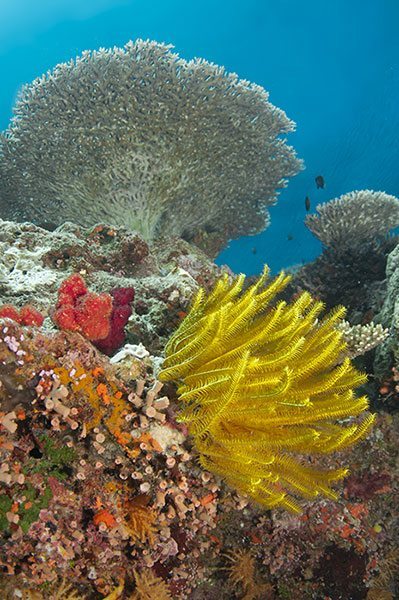
The image shown here can accurately be described as a pleasing seascape, one that shares a scene representative of the setting in many Indo-Pacific reef communities.
Well-schooled underwater shooters should be able to create photographs like this one on a consistent basis when diving in similar settings. After all, I was in relatively calm, shallow water on a sunny day, and my subject was not likely to swim away.
When creating seascapes in similar settings, a stumbling block for many photographers is failing to know how to use their light meter to help properly expose the shot. Know the following: In any photograph that includes a strobe-lit foreground subject and properly exposed blue (or green) water in the background, there are two exposure considerations: the strobe-lit foreground and the sun-lit background.
Your f-stop, strobe-to-subject distance, ISO and the brightness of the light from your strobe determine the exposure of your foreground subject and other strobe-lit foreground elements. The background exposure can and should be determined through the skilled use of the light meter in your camera.
The key to exposure success lies in knowing how to set up and then properly use your light meter.
The key to exposure success lies in knowing how to set up and then properly use your light meter. In many cameras you can set the controls in your camera for your light meter to “read” a very specific area over just a few degrees in the middle of the scene where the camera is aimed (spot metering), over a slightly wider area (center weighted) or over the entire scene with the camera “averaging” the scene to provide your light meter reading (evaluative or matrix metering). The options and methods vary from camera to camera. Depending upon your camera manufacturer, the terminology used here might be different.
When shooting a reef scene of this nature, I use spot metering and I shoot in “manual” mode.
[sam_ad id=”37″ codes=”true”]The point here is that a light meter reading is intended to help you properly expose the water in the background, not the foreground elements. A light meter enables you to measure the brightness of ambient light that you have to work with at a given moment in time. Aim the camera toward the water in your frame that you want to properly expose, note the light meter reading, and you should be able to adjust your f-stop, shutter speed or ISO to properly expose the water.
For a variety of reasons, many photographers fall into the trap of taking their light meter reading by aiming the light meter at their foreground subject. Strobe light, not ambient light, is the main lighting source for all elements in the foreground. A light meter reading helps you properly expose the water in the background of your scene. Your exposure success depends upon understanding this point.
